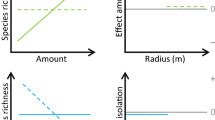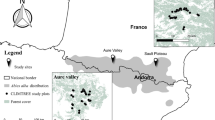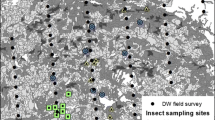Abstract
Context
Species distributions are influenced by habitat conditions and ecological processes at multiple spatial scales. An understanding of the importance of habitat characteristics at different spatial scales is important when developing biodiversity conservation measures.
Objectives
We investigated the effect of habitat characteristics or amount at three spatial scales on the occurrence of saproxylic (=dead wood-dependent) beetles.
Methods
Saproxylic beetles were sampled under the bark of dead wood in a managed forest landscape in central Sweden. We modelled the occurrence probability in dead wood items of 44 species (all species occurring in >2 % of the items), based on dead wood item characteristics, forest stand characteristics, and habitat connectivity (i.e. area of potentially suitable forest stands in the surrounding of each stand), using hierarchical Bayesian regression.
Results
For the majority of species, dead wood item characteristics (especially tree species and whether standing or downed) were more important than measured stand characteristics and habitat connectivity. Whether the stands were clear-cuts, mature forests, or reserves affected some species, whereas the stand-level amount of dead wood per hectare was not important for any species. Habitat connectivity improved the occurrence models for about a half of the species, but there were both positive and negative relationships, and they were generally weak.
Conclusions
Forest management should include creation and retention of a high diversity of dead wood to sustain habitat for all species. In a forest-dominated landscape, the spatial distribution of dead wood is of little importance for common saproxylic beetle species.



Similar content being viewed by others
References
Andrén H (1999) Habitat fragmentation, the random sample hypothesis and critical thresholds. Oikos 84:306–308
Bergeron Y, Leduc A, Harvey BD, Gauthier S (2002) Natural fire regime: a guide for sustainable management of the Canadian boreal forest. Silva Fenn 36:81–95
Berglund H, Hottola J, Penttilä R, Siitonen J (2011) Linking substrate and habitat requirements of wood-inhabiting fungi to their regional extinction vulnerability. Ecography 34:864–875
Bergman K-O, Jansson N, Claesson K, Palmer MW, Milberg P (2012) How much and at what scale? Multiscale analyses as decision support for conservation of saproxylic oak beetles. For Ecol Manag 265:133–141
Dahlberg A, Stokland J (2004) Vedlevande arters krav på substrat—en sammanställning och analys av 3600 arter. Skogsstyrelsen, Jönköping
Davies ZG, Tyler C, Stewart GB, Pullin AS (2008) Are current management recommendations for saproxylic invertebrates effective? A systematic review. Biodivers Conserv 17:209–234
Ekbom B, Schroeder LM, Larsson S (2006) Stand specific occurrence of coarse woody debris in a managed boreal forest landscape in central Sweden. For Ecol Manag 221:2–12
Esseen P-A, Ehnström B, Ericson L, Sjöberg K (1992) Boreal forests—the focal habitats of Fennoscandia. In: Hansson L (ed) Ecological principles of nature conservation. Elsevier Science Publishers, Amsterdam, pp 252–325
Fahrig L (1998) When does fragmentation of breeding habitat affect population survival? Ecol Model 105:273–292
Fahrig L (2013) Rethinking patch size and isolation effects: the habitat amount hypothesis. J Biogeogr 40:1649–1663
Gelman A, Hill J (2007) Data analysis using regression and multilevel/hierarchical models. Cambridge University Press, Cambridge
Götmark F, Åsegård E, Franc N (2011) How we improved a landscape study of species richness of beetles in woodland key habitats, and how model output can be improved. For Ecol Manag 262:2297–2305
Gu W, Heikkilä R, Hanski I (2002) Estimating the consequences of habitat fragmentation on extinction risk in dynamic landscapes. Landscape Ecol 17:699–710
Hjältén J, Stenbacka F, Pettersson RB, Gibb H, Johansson T, Danell K, Ball JP, Hilsczański J (2012) Micro and macro-habitat associations in saproxylic beetles: implications for biodiversity management. PLoS One 7:e41100
Hodgson JA, Moilanen A, Thomas CD (2009) Metapopulation responses to patch connectivity and quality are masked by successional habitat dynamics. Ecology 90:1608–1619
Jackson HB, Baum KA, Cronin JT (2012) From logs to landscapes: determining the scale of ecological processes affecting the incidence of a saproxylic beetle. Ecol Entomol 37:233–243
Jonsell M, Weslien J (2003) Felled or standing retained wood—it makes a difference for saproxylic beetles. For Ecol Manag 175:425–435
Komonen A, Penttilä R, Lindgren M, Hanski I (2000) Forest fragmentation truncates a food chain based on an old-growth forest bracket fungus. Oikos 90:119–126
Lassauce A, Paillet Y, Jactel H, Bouget C (2011) Deadwood as a surrogate for forest biodiversity: meta-analysis of correlations between deadwood volume and species richness of saproxylic organisms. Ecol Indic 11:1027–1039
Leibold MA, Holyoak M, Mouquet N, Amaresekare P, Chase JM, Hoopes MF, Holt RD, Shurin JB, Law R, Tilman D, Loreau M, Gonzalez A (2004) The metacommunity concept: a framework for multi-scale community ecology. Ecol Lett 7:601–613
Levin SA (1992) The problem of pattern and scale in ecology. Ecology 73:1943–1967
Lindhe A, Lindelöw Å, Åsenblad N (2005) Saproxylic beetles in standing dead wood density in relation to substrate sun-exposure and diameter. Biodivers Conserv 14:3033–3053
MacArthur RH, Wilson EO (1967) The theory of island biogeography. Princeton University Press, Princeton, p 203
McGeoch M, Schroeder M, Ekbom B, Larsson S (2007) Saproxylic beetle diversity in a managed boreal forest: importance of stand characteristics and forestry conservation measures. Divers Distrib 13:418–429
Müller J, Bütler R (2010) A review of habitat thresholds for dead wood: a baseline for management recommendations in European forests. Eur J For Res 129:981–992
Nascimbene J, Thor G, Nimis PL (2013) Effects of forest management on epiphytic lichens in temperate deciduous forests of Europe—a review. For Ecol Manag 298:27–38
Nilsson SG, Baranowski R (1997) Habitat predictability and the occurrence of wood beetles in old-growth beech forests. Ecography 20:491–498
Nordén J, Penttilä R, Siiitonen J, Tomppo E, Ovaskainen O (2013) Specialist species of wood-inhabiting fungi struggle while generalists thrive in fragmented boreal forests. J Ecol 101:701–712
Økland B, Bakke A, Hågvar S, Kvamme T (1996) What factors influence the diversity of saproxylic beetles? A multiscaled study from a spruce forest in southern Norway. Biodiver Conserv 5:75–100
Paillet Y, Bergès L, Hjältén J, Ódor P, Avon C, Bernhrdt Römermann M, Bijlsma R-J, deBruyn L, Fuhr M, Grandin U, Kanka R, Lundin L, Luque S, Magura T, Matesanz S, Mészáros I, Sebastià M-T, Schmidt W, Standvár T, Tóthmérész B, Uotila A, Valladares F, Vellak K, Virtanen R (2010) Biodiversity differences between managed and unmanaged forests: meta-analysis of species richness in Europe. Conserv Biol 24:101–112
Penttilä R, Siitonen J, Kuusinen M (2004) Polypore diversity in managed and old-growth boreal Picea abies forests in southern Finland. Biol Conserv 117:271–283
Plummer M (2003) Jags: a program for analysis of Bayesian graphical models using Gibbs sampling. DSC working papers, Austrian Association for Statistical Computing, Vienna
R Development Core Team (2011) R: a language and environment for statistical computing. R Foundation for Statistical Computing, Vienna. ISBN 3-900051-07-0
Ranius T (2002) Influence of stand size and quality of tree hollows on saproxylic beetles in Sweden. Biol Conserv 103:85–91
Ranius T, Jansson N (2000) The influence of forest regrowth, original canopy cover and tree size on saproxylic beetles associated with old oaks. Biol Conserv 95:85–94
Ranius T, Johansson V, Fahrig L (2010) A comparison of patch connectivity measures using data on invertebrates in hollow oaks. Ecography 33:971–978
Ranius T, Bohman P, Hedgren O, Wikars L-O, Caruso A (2014) Metapopulation dynamics of a beetle species confined to burned forest sites in a managed forest region. Ecography 37:797–804
Rolstad J, Løken B, Rolstad E (2000) Habitat selection as a hierarchical spatial process: the green woodpecker at the northern edge of its distribution range. Oecologia 124:116–129
Root RB (1973) Organization of a plant-arthropod association in simple and diverse habitats: the fauna of collards (Brassica oleracea). Ecol Monogr 43:95–124
Rubene D, Wikars L-O, Ranius T (2014) Importance of high quality early-successional habitats in managed forest landscapes to rare beetle species. Biodivers Conserv 23:449–466
Saab V (1999) Importance of spatial scale to habitat use by breeding birds in riparian forests: a hierarchical analysis. Ecol Appl 9:135–151
Sahlin E, Schroeder LM (2010) Importance of habitat patch size for occupancy and density of aspen-associated saproxylic beetles. Biodivers Conserv 19:1325–1339
Saint-Germain M, Drapeau P, Buddle CM (2007) Host-use patterns of saproxylic phloeophagous and xylophagous Coleoptera adults and larvae along the decay gradient in standing dead black spruce and aspen. Ecography 30:737–748
Saunders DA, Hobbs RJ, Margules CR (1991) Biological consequences of ecosystem fragmentation—a review. Conserv Biol 5:18–32
Schroeder LM, Ranius T, Ekbom B, Larsson S (2007) Spatial occurrence of a habitat-tracking saproylic beetle inhabiting a managed forest landscape. Ecol Appl 17:900–909
Siitonen J (2001) Forest management, coarse woody debris and saproxylic organisms: Fennoscandian boreal forests as an example. Ecol Bull 49:11–41
Siitonen J, Saaristo L (2000) Habitat requirements and conservation of Pytho kolwensis, a beetle species of old-growth boreal forest. Biol Conserv 94:211–220
Silfverberg H (2004) Enumeratio nova Coleopterorum Fennoscandiae, Daniae et Baltiae. Sahlbergia 9:1–111
Similä M, Kouki J, Martikainen P, Uotila A (2002) Conservation of beetles in boreal pine forests: the effects of forest age and naturalness on species assemblages. Biol Conserv 106:19–27
Sjörs H (1999) The background: geology, climate and zonation. Acta Phytogeographica Suecica 84:5–14
Southwood TRE, Henderson PA (2000) Ecological methods. Blackwell Science, Oxford
Spiegelhalter DJ, Best NJ, Carlin BP, vad der Linde A (2002) Bayesian measures of model complexity and fit. J R Stat Soc B 64:583–616
Stenbacka F, Hjältén J, Hilszczański J, Dynesius M (2010) Saproxylic and non-saproxylic beetle assemblages in boreal spruce forests of different age and forestry intensity. Ecol Appl 20:2310–2321
Stokland J, Kauserud H (2004) Phellinus nigrolimitatus—a wood-decomposing fungus highly influenced by forestry. For Ecol Manag 187:333–343
Stokland JN, Siitonen J, Jonsson BG (2012) Biodiversity in dead wood. Cambridge University Press, Cambridge
Sverdrup-Thygeson A, Midtgaard F (1998) Fungus-infected trees as islands in boreal forest: spatial distribution of the fungivorous beetle Bolitophagus reticulatus (Coleoptera, Tenebrionidae). Ecoscience 5:486–493
Sverdrup-Thygeson A, Gustafsson L, Kouki J (2014) Spatial and temporal scales relevant for conservation of dead-wood associated species: current status and perspectives. Biodivers Conserv 23:513–535
Thomas CD, Thomas JA, Warren MS (1992) Distributions of occupied and vacant butterfly habitats in fragmented landscapes. Oecologia 92:563–567
Ulyshen MD, Hanula JL (2009) Habitat associations of saproxylic beetles in the southeastern United States: a comparison of forest types, tree species and wood postures. For Ecol Manag 257:653–664
Victorsson J, Jonsell M (2013) Effect of stump extraction on saproxylic beetle diversity in Swedish clear-cuts. Insect Conserv Divers 6:483–493
Wiens JA (1989) Spatial scaling in ecology. Funct Ecol 3:385–397
Wikars LO (2002) Dependence on fire in wood-living insects: an experiment with burned and unburned spruce and birch logs. J Insect Conserv 6:1–12
Wikars LO, Sahlin E, Ranius T (2005) A comparison of three methods to estimate species richness of saproxylic beetles (Coleoptera) in logs and high stumps of Norway spruce. Can Entomol 137:304–332
Acknowledgments
We thank Holmen Skog for access to their databases. Matilda Apelqvist, Björn Forsberg, Markus Franzén, David Isaksson, Niklas Jönsson, Mats Larsson, Per Larsson, Carola Orrmalm, Erik Sahlin, Måns Svensson, and Jan ten Hoopen helped with field and laboratory work. Stig Lundberg identified the beetles. Håkan Berglund, Matthew Hiron, Joakim Hjältén, and Tobias Jeppsson provided valuable comments on the manuscript. The study was supported by the Mistra research program Future Forests (to TR).
Author information
Authors and Affiliations
Corresponding author
Electronic supplementary material
Below is the link to the electronic supplementary material.
Rights and permissions
About this article
Cite this article
Ranius, T., Johansson, V., Schroeder, M. et al. Relative importance of habitat characteristics at multiple spatial scales for wood-dependent beetles in boreal forest. Landscape Ecol 30, 1931–1942 (2015). https://doi.org/10.1007/s10980-015-0221-5
Received:
Accepted:
Published:
Issue Date:
DOI: https://doi.org/10.1007/s10980-015-0221-5




